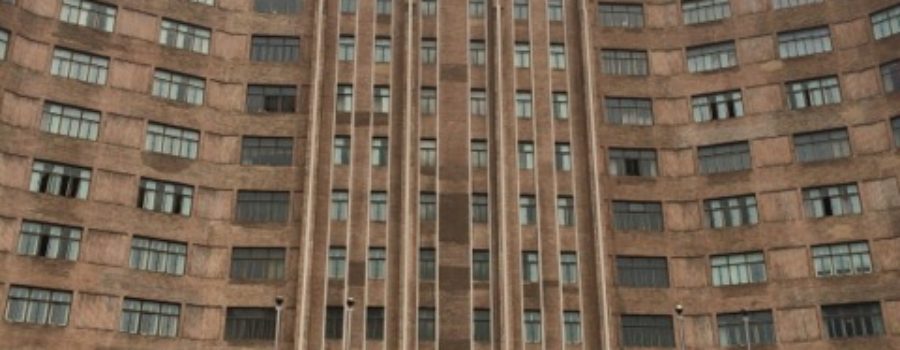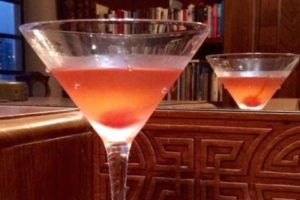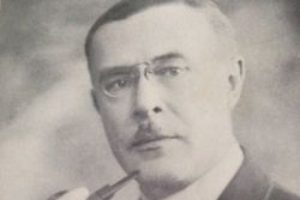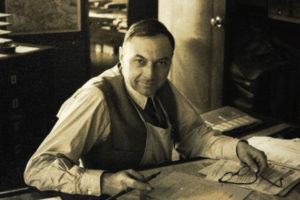Hurtling west on the Yan’an Road elevated highway, a pair of stately buildings from another age catch the eye. One is a Gothic tower of brown brick that would not look out of place in Manhattan. The second building, the more stylish of the two, has a central tower that opens out to stepped Art Deco wings, as if in embrace. You can’t help but give this elegant sophisticate from another age (still a presence among the brash, new skyscrapers that surround her) a double-take.
When the tower building first went up in 1929, it was located just steps from the Canidrome greyhound racetrack, and like the sport of greyhound racing that was so popular in old Shanghai, Cathay Mansions was a gamble.
The Cathay Land Company, owned by the colorful Shanghai tycoon Sir Victor Sassoon (owner of the landmark Cathay Hotel (today the Fairmont Peace Hotel) on the Bund and many other major properties) had commissioned the British firm Arnhold & Company to build an 18-storey residential hotel inspired by the skyscrapers in America, but Shanghai’s famously swampy ground had never supported building of that height before. It was a gamble that Sassoon – a gambler himself, both in business and at the track – was willing to take.
After the success of the Cathay Hotel, reported Fortune magazine in 1935, “they [the Sassoon company] next proceeded to apartment houses designed to relieve taipans of the onus of maintaining big mansions, heavily staffed.” It would be great success – if the ground held up.
The gamble, as with most of Sir Victor Sassoon’s gambles, paid off handsomely. The ground did hold up, and Cathay Mansions became a popular address. No wonder: It had location, location, location on its side.
Situated directly opposite the Cercle Sportif Francais (now the Okura Garden Hotel), the Lyceum Theater was in the next block (their Amateur Dramatic Club’s “Green Room” bar was a popular spot) and, of course, the Canidrome was just around the corner. No wonder it attracted playboys, reports Shanghai historian Tess Johnston, like the nephew of Mrs Wellington Koo, wife of the famous diplomat, who lived in one of the duplex apartments where marble staircases led to the bedrooms. It was that sort of place: in the wonderful memoir Foreigners Have Light Eyes Dora Carney describes taking tea with her future husband’s elegant French mistress here.
As one of the wealthiest men in old Shanghai, Sir Victor Sassoon could afford to take a gamble. The Sassoon fortune began with David Sassoon, a Sephardic Jew in Baghdad, Iraq, who set up the Sassoon Company in Bombay in 1833. By 1844, he had set up a branch in Hong Kong, and in 1845 – just three years after the “Treaty of Nanking” had opened Shanghai to trade – he opened a branch on the Bund. His goal, and that of nearly every businessman in Shanghai at the time, was to cash in on the opium trade.
And cash in he did: It was not long before one-fifth of the opium trade brought into China came in on the Sassoon fleet, along with British textiles. They left China with tea, silk and silver, and soon the Sassoons became the wealthiest family in India.
In 1918, Sir Victor Sassoon, a fourth generation Sassoon, inherited the business, arriving in Shanghai in 1923, where he immediately set about changing the city landscape. Known as much for his flamboyant costume parties and horse and greyhound racing as for his business acumen, he opened more than 30 companies in Shanghai. His legacy, however, was the real estate he left behind: In addition to the Cathay Complex and the Cathay Hotel, his properties included the Cathay Cinema, just down the road from the complex, at the corner of Maoming Road and Huaihai Road; Hamilton Building and Metropole Hotel (the skyscrapers at the corner of Fuzhou Road and Jiangxi Road); and the Embankment Building on North Suzhou Road.
Cathay Mansions was such a success that before long, Sassoon was commissioning British architects Palmer & Turner to build an even more luxurious building, this one with a large garden: Grosvenor House.
The apartments featured high ceilings, gorgeous Art Deco lamps, claw-foot bathtubs, and polished parquet floors. (The garden has since been encroached upon, but is still a decent-sized green sward, and the apartments “modernized”).

Grosvenor House, as seen from the lawn tennis courts of the Cercle Sportif Francais, across the street.
The Cathay complex also contained Grosvenor Gardens, walk-up apartments on Rue Cardinal Mercier (today’s Maoming Road). The rents for these low-rise units were cheaper, and thanks to their location, they were a convenient and popular address, housing the likes of people such as the Stead sisters. In their book, Stone, Paper, Scissors, the four sisters who lived in Shanghai from 1921 to 1945 described their Grosvenor Gardens apartment: “The apartment consisted of a dining room, lounge and study (open plan), two bedrooms, two bathrooms, large kitchen and servants’ quarters on the top floor.” A photograph shows wide windows, parquet floors and chic modernist lamps hanging from the high ceilings.
Victor Sassoon had left Shanghai by the time the new Communist rulers had liberated the city, and his properties. Sassoon never returned, but his legacy remained: When Shanghai needed a place for foreign dignitaries to stay, they turned to Cathay Mansions, and a woman named Dong Zhujun.
Born in 1900 in Shanghai, the story is that Dong was sold to a brothel as a young girl, but had her freedom purchased by a Kuomintang soldier. She married him and the couple moved to Japan, where she attended university. They later moved back to China, to his home province in Sichuan. Unhappy with his lifestyle (which was heavy on drinking, gambling and women), Dong left him and moved back to Shanghai, where she opened a textile factory – the first woman to do so. When the factory was bombed during the Japanese invasion, Dong moved on. Drawing on her years in Sichuan, she opened the Jinjiang Sichuan Restaurant in 1935 (where she was head chef) and a year later, the Jinjiang Tea House. In 1949, Dong began running Cathay Mansions as a government guesthouse, and in 1950, the restaurant and teahouse were moved to Cathay Mansions – where they remain – and the hotel became the Jinjiang Hotel.
Since then, a who’s who of political leaders have stayed here, from former British Prime Minister Margaret Thatcher and former US President Ronald Reagan to Cuban President Fidel Castro, but the names most associated with the Jinjiang Hotel are the late Chinese Premier Zhou Enlai and former US President Richard Nixon. For it was here, on February 27 1972, in the red brick Jinjiang Grand Hall (built in 1959), that the two countries signed the historic “Shanghai Communique,” the first step in the normalization of Sino-US relations. As it turns out, the duplex apartment that Nixon stayed in, with the marble staircase leading to the bedrooms, was the very same one that had been owned by Mrs Koo’s playboy nephew.
Today, Grosvenor Gardens are used as office space, and the Jinjiang Hotel is showing its age. But over at Grosvenor House, despite a renovation that robbed the interior of its original style, it feels like the old days. Attracted by the location, the style, and the history, an impressive collection of Shanghai’s A-list – socialites, fashionistas, diplomats and journalists –now lives here. Once again, it is Shanghai’s premier address.
An earlier version of this article first appeared in the Shanghai Daily as “Old Shanghai’s Best Address”.












Most Commented Posts